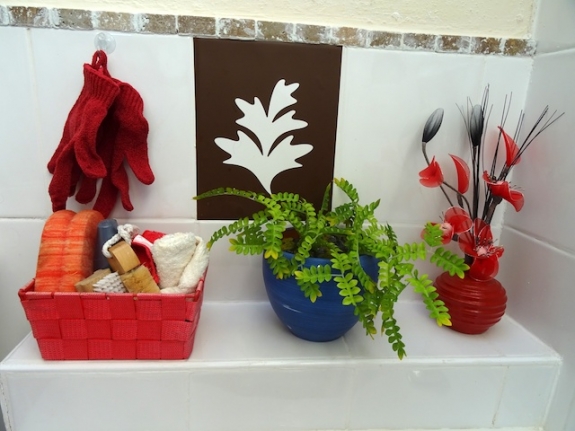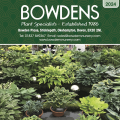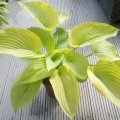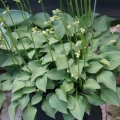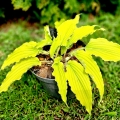Online Shop
128
Royal Horticultural Society
Gold Medals
Royal Horticultural Society
Gold Medals
- Home
- About Ferns
- Indoor Ferns
Indoor Ferns
Our resident fern expert Dick Hayward writes about Indoor Ferns.
First of all I think it is necessary to know that only a relatively small number of ferns are suitable for growing indoors. Most of the British native ferns will not survive for long indoors, and the same is true of almost all garden ferns that are sold in garden centres. But there are four groups (genera) of ferns that are often sold as houseplants at garden centres, and, given proper attention, these are usually reliable. The four groups are: Brake Ferns (the Pteris genus), Maidenhair Ferns (the Adiantum genus), Ladder Ferns (the Nephrolepis genus) and the Spleenwort Ferns (Asplenium genus).
Of the Brake Ferns the following are easy to grow indoors: *Pteris cretica (the Cretan Brake Fern) which comes in a variety of forms, Pteris ensiformis (the commonest form of this is known as 'Victoriae'), *Pteris nipponica (the Japanese Variegated Brake Fern), Pteris argyrea (the Silver-Brake Fern), *Pteris umbrosa (the Australian Jungle-Brake Fern), Pteris aspericaulis (especially the attractive variety of this known as 'Tricolor', which, as the name suggests, displays three different colour fronds). None of these will grow outdoors however.
Of the Maidenhair Ferns, only a few of the hundreds of species growing in the tropics are actually available in UK garden centres. The three you are most likely to find are: Adiantum raddianum (the Delta Maidenhair or Pacific Maidenhair), Adiantum tenerum (the Brittle Maidenhair or Fan Maidenhair) and a hybrid named *Adiantum X mairisii, all these come in a range of frond shapes and colours - all very attractive. There is another quite small species called Adiantum caudatum which you can sometimes find and it survives ok if the location is suitably humid (see below on 'humidity').
Of the Ladder ferns there are again only two that are commonly available, namely: Nephrolepis exaltata (the Boston Ladder Fern) and *Nephrolepis cordifoilia (the Potato Fern). Both have many beautiful varieties, and all are especially suitable for hanging baskets indoors.
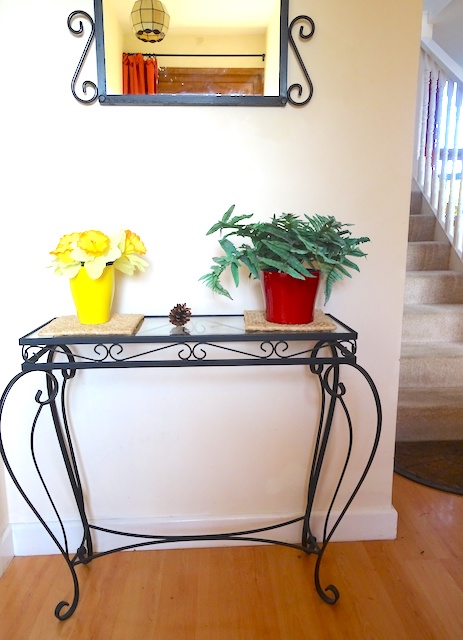
Boston Ladder Fern - Nephrolepis exaltata
There are a number of good Spleenwort fern houseplant Aspleniums; namely: the Hen and Chicken Fern (Asplenium bulbiferum), the Mauritius Spleenwort (Asplenium daucifolium), and an attractive hybrid between A. bulbiferum and the Australian A. surrogatum. Relatively recently a new hybrid has appeared in the trade known as 'Parvati' or 'Austral Gem'. It is the cross between the Australian species A. diforme and A. dimorphum. All of the preceding have finely divided fronds, looking a bit like carrot leaves. Contrasting with these are the Birds Nest Ferns, Aspolenium nidus and Asplenium antiquum. Both are very suitable for hanging basket culture, though the former can grow huge, and should go into a pot on the ground before it gets too big - it wouldn't be good to have it pull the plasterboard down! The latter is more modest in size and has several attractive forms, one of which has a beautifully undulating edge. Of course there are hundreds of Aspleniums, but the above are the only ones people are likely to encounter in garden centres.
In addition to the above, there some other species belonging to various different groups that are good for indoors. I will mention just half-a-dozen of these: *Button Fern (Pellaea rotundifolia), Haresfoot Fern (Phlebodium aureum), Rabbitsfoot Fern (Davallia trichomanoides and Davallia tyermannii), Staghorn Fern (Platycerium bifurcatum, and Platycerium grande), *Japanese Holly Fern (Cyrtomium falcatum).
It is necessary to say something about growing conditions. First of all ferns need a fair degree of humidity. Bathrooms and kitchens are often the most naturally humid places in the house. But if we place the pot on a plastic plant pot saucer containing water and a water-absorbant compound sold as Hortag, this will provide an atmosphere of humidity around the plant above it. Obviously we need to avoid putting a fern close to a radiator or central heating vent. Likewise hot sunny places should be avoided. Rooms with north-facing windows are good. Try to keep the compost slightly moist but avoid over-watering so that the plant is sitting in water. Do not fertilise nearly as much as you would with a non-fern houseplant. Weak solutions of fertiliser (often at half the recommended strength are best - maybe at once a fortnight intervals. If growth is good, you will need to re-pot into fresh compost at least once a year. I have found a 33% John Innes No 2 compost with 66% Miracle-Gro compost to be suitable for most ferns in pots - and with these you won't need to bother about an extra fertiliser. Nephrolepis, Phlebodium and Davallia all grow best in hanging baskets. Most books on houseplants will give good advice about planting these and maintaining them properly.
Bowdens stocks some of the above (highlighted with links), and it is worth enquiring from time to time as other species and varieties come in at different times in the year.
First of all I think it is necessary to know that only a relatively small number of ferns are suitable for growing indoors. Most of the British native ferns will not survive for long indoors, and the same is true of almost all garden ferns that are sold in garden centres. But there are four groups (genera) of ferns that are often sold as houseplants at garden centres, and, given proper attention, these are usually reliable. The four groups are: Brake Ferns (the Pteris genus), Maidenhair Ferns (the Adiantum genus), Ladder Ferns (the Nephrolepis genus) and the Spleenwort Ferns (Asplenium genus).
Of the Brake Ferns the following are easy to grow indoors: *Pteris cretica (the Cretan Brake Fern) which comes in a variety of forms, Pteris ensiformis (the commonest form of this is known as 'Victoriae'), *Pteris nipponica (the Japanese Variegated Brake Fern), Pteris argyrea (the Silver-Brake Fern), *Pteris umbrosa (the Australian Jungle-Brake Fern), Pteris aspericaulis (especially the attractive variety of this known as 'Tricolor', which, as the name suggests, displays three different colour fronds). None of these will grow outdoors however.
Of the Maidenhair Ferns, only a few of the hundreds of species growing in the tropics are actually available in UK garden centres. The three you are most likely to find are: Adiantum raddianum (the Delta Maidenhair or Pacific Maidenhair), Adiantum tenerum (the Brittle Maidenhair or Fan Maidenhair) and a hybrid named *Adiantum X mairisii, all these come in a range of frond shapes and colours - all very attractive. There is another quite small species called Adiantum caudatum which you can sometimes find and it survives ok if the location is suitably humid (see below on 'humidity').
Of the Ladder ferns there are again only two that are commonly available, namely: Nephrolepis exaltata (the Boston Ladder Fern) and *Nephrolepis cordifoilia (the Potato Fern). Both have many beautiful varieties, and all are especially suitable for hanging baskets indoors.
Boston Ladder Fern - Nephrolepis exaltata
There are a number of good Spleenwort fern houseplant Aspleniums; namely: the Hen and Chicken Fern (Asplenium bulbiferum), the Mauritius Spleenwort (Asplenium daucifolium), and an attractive hybrid between A. bulbiferum and the Australian A. surrogatum. Relatively recently a new hybrid has appeared in the trade known as 'Parvati' or 'Austral Gem'. It is the cross between the Australian species A. diforme and A. dimorphum. All of the preceding have finely divided fronds, looking a bit like carrot leaves. Contrasting with these are the Birds Nest Ferns, Aspolenium nidus and Asplenium antiquum. Both are very suitable for hanging basket culture, though the former can grow huge, and should go into a pot on the ground before it gets too big - it wouldn't be good to have it pull the plasterboard down! The latter is more modest in size and has several attractive forms, one of which has a beautifully undulating edge. Of course there are hundreds of Aspleniums, but the above are the only ones people are likely to encounter in garden centres.
In addition to the above, there some other species belonging to various different groups that are good for indoors. I will mention just half-a-dozen of these: *Button Fern (Pellaea rotundifolia), Haresfoot Fern (Phlebodium aureum), Rabbitsfoot Fern (Davallia trichomanoides and Davallia tyermannii), Staghorn Fern (Platycerium bifurcatum, and Platycerium grande), *Japanese Holly Fern (Cyrtomium falcatum).
It is necessary to say something about growing conditions. First of all ferns need a fair degree of humidity. Bathrooms and kitchens are often the most naturally humid places in the house. But if we place the pot on a plastic plant pot saucer containing water and a water-absorbant compound sold as Hortag, this will provide an atmosphere of humidity around the plant above it. Obviously we need to avoid putting a fern close to a radiator or central heating vent. Likewise hot sunny places should be avoided. Rooms with north-facing windows are good. Try to keep the compost slightly moist but avoid over-watering so that the plant is sitting in water. Do not fertilise nearly as much as you would with a non-fern houseplant. Weak solutions of fertiliser (often at half the recommended strength are best - maybe at once a fortnight intervals. If growth is good, you will need to re-pot into fresh compost at least once a year. I have found a 33% John Innes No 2 compost with 66% Miracle-Gro compost to be suitable for most ferns in pots - and with these you won't need to bother about an extra fertiliser. Nephrolepis, Phlebodium and Davallia all grow best in hanging baskets. Most books on houseplants will give good advice about planting these and maintaining them properly.
Bowdens stocks some of the above (highlighted with links), and it is worth enquiring from time to time as other species and varieties come in at different times in the year.
New Additions
-
Bowdens 2024 Catalogue £0.00

-
Wundergold £15.00

-
venusta 'Porter' £8.00

-
Valley's Love Birds £14.00

-
Valley's Lemon Squash £14.00

